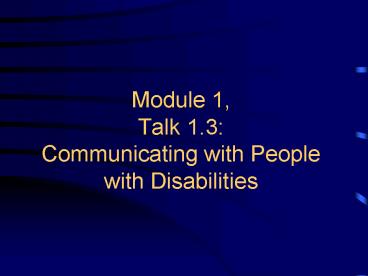Module 1, Talk 1'3: Communicating with People with Disabilities - PowerPoint PPT Presentation
1 / 19
Title:
Module 1, Talk 1'3: Communicating with People with Disabilities
Description:
Communication Barriers for People with Spinal Cord Injury. National Rehabilitation Hospital, ... Cooperation in treatment and rehabilitation ... – PowerPoint PPT presentation
Number of Views:84
Avg rating:3.0/5.0
Title: Module 1, Talk 1'3: Communicating with People with Disabilities
1
Module 1, Talk 1.3Communicating with People
with Disabilities
2
Communication Barriers for People with Spinal
Cord Injury
- National Rehabilitation Hospital,
- Washington, DC
3
The Consumer Professional Partnership Program
- Consumers co-present in education settings for
health care professionals - The SCI Life Educator Concept
- Training Manual
- Disability Awareness and Communication
- Prevention of Secondary Conditions
- Physical Activity and Exercise
4
Goals
- To identify communication issues and needs when
interacting with people with SCI - To determine critical communication skills
- To identify strategies to improve communication
with individuals who have disabilities
5
Why is communication important?
- Builds the rapport and mutual respect needed in
order to achieve - Accuracy in exchange of information
- Receptiveness of information
- Cooperation in treatment and rehabilitation
- Prevention of secondary conditions and medical
complications
6
Types of Communication Barriers
- Attitudes and Behaviors
- Physical/Individual
- Environmental
7
Attitudes and Behaviors
- Halo-Effect Physical limitations in specific
functions are interpreted in terms of limitations
of the person - Confounding physical, cognitive and linguistic
abilities - Stereotyping
8
Attitudes and Behaviors, cont.
- Lack of knowledge about SCI
- Lack of attention to issues other than SCI (e.g.,
preventive screenings, sexuality, exercise,
wellness, aging)
9
Physical/Individual Barriers
- Changes in the ability to communicate verbally
- Changes in communication due to functional
limitations (use of arms and hands) and body
position (wheelchair)
10
Environmental Barriers
- Transportation
- Availability
- Timeliness
- Cost
- Office accessibility
- Parking
- Elevators and doorways
- Examination rooms
- Diagnostic equipment
- Staff communication
11
Strategies to Address Attitudes and Behaviors
- Acknowledgement of and addressing an individual
with SCI - Address the patient in a manner befitting adults
- Never lean on the wheelchair, as the wheelchair
is a part of his or her personal space - When they are accompanied by an able-bodied
person, do not ignore the patient or talk only to
the able-bodied person
12
Strategies to Address Attitudes and Behaviors,
cont.
- Do not assume the patient with a SCI needs
assistance - Ask if you can help and then follow the
instructions given to you - If your assistance is declined, don't be offended
and do not proceed with assistance - Do not discourage their active participation
13
Strategies to Address Physical/Individual Barriers
- Maintain eye contact
- Use a normal tone of voice -- do not raise your
voice unless requested - When introduced to a person with a SCI, it is
appropriate to offer to shake hands - Shaking hands with the left hand is acceptable
14
Strategies to Address Environmental Barriers
- Be flexible if a patient is late for a scheduled
appointment - Let your patient know about any physical barriers
in your office/building environment before they
arrive for their appointment
15
Strategies to Address Environmental Barriers,
cont.
- Make sure your waiting area is free of clutter on
the floor and provides enough space for a
wheelchair to maneuver - Schedule patients with a SCI in rooms with
accessible exam tables - Exam rooms need to be able to accommodate a
wheelchair (e.g., turning radius, etc.)
16
Use of Appropriate Terminology
- Awareness of language and terminology is critical
for the development of a trusting relationship
between the individual with a SCI and the
healthcare provider - In the medical community it is not uncommon to
identify people by their condition as if that
constitutes their whole identity
17
Terminology
18
Terminology, cont.
- Avoid using
- The adjective as a noun, e.g. the disabled, a
paraplegic - People suffering from or afflicted with
(implying victim role) a disability - Handicapped, crippled, invalid, spastic,
special, or challenged - Visually-handicapped person
- Deaf and dumb, or deaf and mute
- Wheelchair-bound or Confined to a wheelchair
- Carers
19
Optional Teaching Exercise
- Circle the terms that you think are appropriate
for describing a patient with spinal cord injury - wheelchair-bound spastic special
- the disabled spinal cord injured cripple
- invalid integrated independent individual
- special needs wheelchair user brave
- sufferer handicapped person with a SCI































